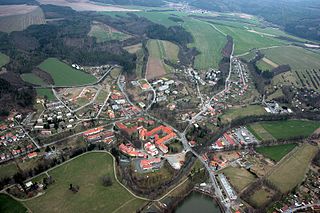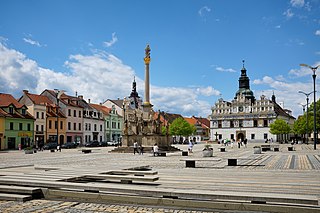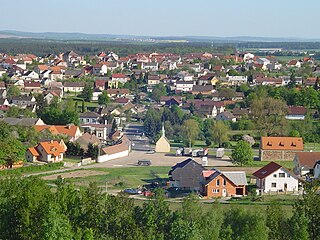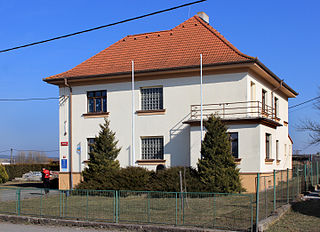
Plasy is a town in Plzeň-North District in the Plzeň Region of the Czech Republic. It has about 3,000 inhabitants. It is known for its former monastery of the same name, which is protected as a national cultural monument.

Kožlany is a town in Plzeň-North District in the Plzeň Region of the Czech Republic. It has about 1,500 inhabitants.

Stříbro is a town in Tachov District in the Plzeň Region of the Czech Republic. It has about 8,000 inhabitants. The historic town centre with the Renaissance Stříbro bridge is well preserved and is protected by law as an urban monument zone.

Březnice is a town in Příbram District in the Central Bohemian Region of the Czech Republic. It has about 3,500 inhabitants. The historic town centre is well preserved and is protected by law as an urban monument zone.

Kralovice is a town in Plzeň-North District in the Plzeň Region of the Czech Republic. It has about 3,500 inhabitants. It is known for the former pilgrimage site of Mariánská Týnice.

Stod is a town in Plzeň-South District in the Plzeň Region of the Czech Republic. It has about 3,600 inhabitants.

Nýřany is a town in Plzeň-North District in the Plzeň Region of the Czech Republic. It has about 7,000 inhabitants.

Město Touškov is a town in Plzeň-North District in the Plzeň Region of the Czech Republic. It has about 2,400 inhabitants. The historic town centre is well preserved and is protected by law as an urban monument zone.

Třemošná is a town in Plzeň-North District in the Plzeň Region of the Czech Republic. It has about 5,100 inhabitants.

Radnice is a town in Rokycany District in the Plzeň Region of the Czech Republic. It has about 1,900 inhabitants.

Krupka is a town in Teplice District in the Ústí nad Labem Region of the Czech Republic. It has about 13,000 inhabitants. The town is located in the Ore Mountain Mining Region, a UNESCO World Heritage Site, and during the late Middle Ages it was one of the world-leading producers of tin and silver. The centre of Krupka is well preserved and is protected by law as an urban monument zone.

Plzeň-North District is a district in the Plzeň Region of the Czech Republic. Its capital is the city of Plzeň. The most populated town of the district is Nýřany.

Horní Slavkov is a town in Sokolov District in the Karlovy Vary Region of the Czech Republic. It has about 5,400 inhabitants. The historic town centre is well preserved and is protected by law as urban monument zone.

Horní Blatná is a town in Karlovy Vary District in the Karlovy Vary Region of the Czech Republic. It has about 400 inhabitants. The town is historically associated with tin mining and is located in the Ore Mountain Mining Region, which is a UNESCO World Heritage Site. The historic town centre is well preserved and is protected by law as an urban monument zone.

Kaznějov is a town in Plzeň-North District in the Plzeň Region of the Czech Republic. It has about 3,100 inhabitants.

Chrást is a municipality and village in Plzeň-City District in the Plzeň Region of the Czech Republic. It has about 1,900 inhabitants.

Kbelany is a municipality and village in Plzeň-North District in the Plzeň Region of the Czech Republic. It has about 100 inhabitants.

Tlučná is a municipality and village in Plzeň-North District in the Plzeň Region of the Czech Republic. It has about 3,400 inhabitants.

Horní Kamenice is a municipality and village in Plzeň-South District in the Plzeň Region of the Czech Republic. It has about 300 inhabitants.

Heřmanova Huť is a municipality in Plzeň-North District in the Plzeň Region of the Czech Republic. It has about 1,800 inhabitants.
























